List of palms native to the Caribbean facts for kids
The palm family, known as Arecaceae, is very common across the Caribbean islands. Worldwide, there are about 191 different groups (called genera) and 2339 types (called species) of palms. Many of these palms love islands! About 36% of all palm groups and 52% of all palm types are found only on islands. Also, 62% of palm groups that have only one species are found just on islands.
The Caribbean region for plants includes coastal areas of the United States (like south Florida), Mexico (especially the Yucatan), Belize, Colombia, and Venezuela. Most palm species either live in many places, including parts of the Caribbean, or they are found only in the Greater Antilles. Cuba has the most palm species in the Caribbean, followed by Hispaniola. The Windward and Leeward Islands have the fewest. Palms in Trinidad and Tobago are mostly types found in South America. Three palm groups are found only in the Greater Antilles: Calyptronoma, Hemithrinax, and Zombia. Even though you see coconut palms (Cocos nucifera) everywhere in the Caribbean, they are not originally from there! The Copernicia palms in the Caribbean are all found only in the Greater Antilles. Two types are only on Hispaniola, and the others are only on Cuba.
Contents
- Amazing Palm Groups of the Caribbean
- Acoelorraphe: The Slender Fan Palm
- Acrocomia: Spiny Palms Everywhere
- Aiphanes: Small Spiny Beauties
- Astrocaryum: Palms with Long Spines
- Attalea: Giant Palms of the Neotropics
- Bactris: Diverse Spiny Palms
- Calyptronoma: Palms of Wet Areas
- Coccothrinax: Fan Palms of the Caribbean
- Colpothrinax: Cuban Endemic Palm
- Copernicia: Spiny Fan Palms of the Greater Antilles
- Desmoncus: Scrambling Spiny Palms
- Euterpe: Beautiful American Palms
- Gaussia: Caribbean and Central American Palms
- Geonoma: Forest Understory Palms
- Hemithrinax: Cuban Fan Palms
- Leucothrinax: A Northern Caribbean Native
- Manicaria: Palms with Unique Leaves
- Mauritia: South American Giants
- Oenocarpus: Palms of Trinidad
- Prestoea: Related to Euterpe Palms
- Pseudophoenix: Palms Across the Caribbean
- Reinhardtia: Small Forest Palms
- Roystonea: Royal Palms of the Caribbean
- Sabal: Fan Palms of Many Habitats
- Syagrus: Lesser Antillean Endemic
- Thrinax: Another Fan Palm Group
- Zombia: The Unique Haitian Palm
- See also
Amazing Palm Groups of the Caribbean
This section explores some of the cool palm groups found in the Caribbean.
Acoelorraphe: The Slender Fan Palm
Acoelorraphe is a palm group with only one species, Acoelorraphe wrightii. It grows around the edges of the Caribbean Sea, from Florida to islands like San Andrés and Providencia in Colombia. This palm is a thin fan palm that can grow up to 7 meters (23 feet) tall. It often has many stems growing close together. Acoelorraphe wrightii usually lives in low, wet areas near the sea, like flooded forests or grassy plains.
Acrocomia: Spiny Palms Everywhere
Acrocomia is a group of spiny palms found all over the Neotropics, from Mexico to Argentina and across the Caribbean. Because they cover such a large area and look different in various places, many types have been described. Most experts agree on three main species: A. aculeata, A. crispa, and A. hassleri. Caribbean Acrocomia palms have single, spiny stems that can be 4 to 18 meters (13 to 59 feet) tall.
- Acrocomia aculeata: Found in Cuba, the Dominican Republic, Haiti, Jamaica, the Leeward Islands, Windward Islands, and Trinidad and Tobago. It also grows in Mexico, Central, and South America.
- Acrocomia crispa: Found only in Cuba.
- Acrocomia media: Found in Puerto Rico and the Virgin Islands.
Aiphanes: Small Spiny Beauties
Aiphanes palms are small to medium-sized and very spiny. Caribbean species have single stems and grow 3 to 18 meters (10 to 59 feet) tall. Most of the 23 Aiphanes species live in the Andes mountains. Two species are found in the Caribbean, including A. minima, which is found only in this region.
- Aiphanes horrida: Found in Trinidad and tropical South America.
- Aiphanes minima: Found in the Dominican Republic, Puerto Rico, Martinique, Dominica, Saint Lucia, Saint Vincent, Barbados, and Grenada.
Astrocaryum: Palms with Long Spines
Astrocaryum palms are known for their sharp, flat spines that can be up to 30 cm (12 inches) long and cover their trunks. These palms are native to Mexico, Trinidad, Central, and South America. The Caribbean species has single stems, growing 8 to 20 meters (26 to 66 feet) tall. There are about 36 species in this group. One, A. aculeatum, is found on Caribbean islands.
- Astrocaryum aculeatum: Found in Trinidad and tropical South America.
Attalea: Giant Palms of the Neotropics
Attalea is a large group that includes some of the biggest palms in the Neotropics. Three of the 67 species are found on Caribbean islands. Two of these are only in Trinidad and Tobago, which is close to the continent. The third species, A. crassispantha, is found only in southwest Haiti. It is a critically endangered species because there are very few left.
- Attalea crassispatha: Found only in southwest Haiti.
- Attalea maripa: Found in Trinidad and tropical South America.
- Attalea osmantha: Found in Trinidad and Tobago, and northern Venezuela.
Bactris: Diverse Spiny Palms
Bactris is a very large and diverse group of palms found from southern Mexico to northern Paraguay. Most species are medium-sized, spiny palms with many stems growing in clumps. Most Caribbean Bactris palms are spiny trees 1 to 10 meters (3 to 33 feet) tall with pinnate leaves. One species, B. simplicifrons, is smaller (0.5–2 m) and often has simple leaves without spines.
Seven of the 75 Bactris species are found on Caribbean islands. Three species—B. cubensis, B. jamaicana, and B. plumeriana—are found only in the Greater Antilles. The other four are South American species that also grow in Trinidad and Tobago.
- Bactris cubensis: Found in eastern Cuba.
- Bactris jamaicana: Found only in Jamaica.
- Bactris plumeriana: Found only in Hispaniola.
Calyptronoma: Palms of Wet Areas
Palms in the Calyptronoma group have compound leaves that look like feathers and large, single stems that grow 4 to 15 meters (13 to 49 feet) tall. This group is found only in the Greater Antilles, where they live in wet areas near streams.
- Calyptronoma occidentalis: Found only in Jamaica.
- Calyptronoma plumeriana: Found in Cuba and Hispaniola.
- Calyptronoma rivalis: Found in Hispaniola and Puerto Rico.
Coccothrinax: Fan Palms of the Caribbean
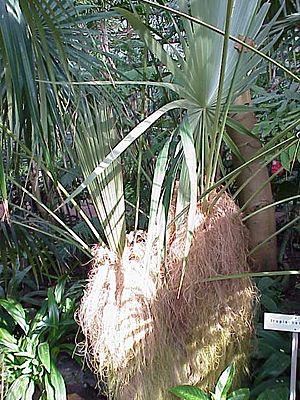
Coccothrinax is a group of beautiful fan palms found all over the Caribbean and in nearby parts of southern Florida and Mexico. Most species are small to medium-sized, reaching heights between 5 and 15 meters (17 and 49 feet). There are 55 species in this group, and almost all of them are found on Caribbean islands. Many species are found only in Cuba and Hispaniola.
- Coccothrinax argentata: Found in the Bahamas, Florida Keys, and San Andrés Island.
- Coccothrinax barbadensis: Found in the Leeward Islands, Windward Islands, Netherlands Antilles, and Trinidad and Tobago.
- Coccothrinax crinita: Known for its "hairy" trunk, found in Cuba.
Colpothrinax: Cuban Endemic Palm
Colpothrinax is a group of palms with single stems and pinnate leaves. They are native to Central America and the Caribbean. There are three species of Colpothrinax. Two are found only in Central America, and one, C. wrightii, is found only in Cuba.
- Colpothrinax wrightii: Found in southwest Cuba, including the Isle of Youth.
Copernicia: Spiny Fan Palms of the Greater Antilles
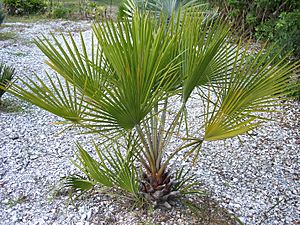
Copernicia is a fairly large group of spiny fan palms found in the Caribbean and South America. All the Caribbean species are found only in the Greater Antilles. Two species are found only on Hispaniola, while the others are found only in Cuba.
- Copernicia baileyana: Found in east and central Cuba.
- Copernicia berteroana: Found in Haiti and the Dominican Republic.
- Copernicia gigas: A very large species found in east Cuba.
Desmoncus: Scrambling Spiny Palms
Desmoncus is a group of spiny, scrambling palms with pinnate leaves. They grow from Mexico in the north down to Bolivia and Brazil in the south. Most of the twelve species in this group are found only on the mainland. Two species are found on both the mainland and on Caribbean islands.
- Desmoncus orthacanthos: Found in Trinidad and Tobago and tropical South America.
- Desmoncus polyacanthos: Found in Saint Vincent and the Grenadines and Trinidad and Tobago, as well as tropical South America.
Euterpe: Beautiful American Palms
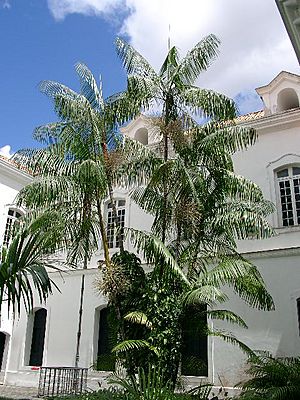
Euterpe includes seven slender-stemmed palms with pinnate leaves. They are native to the Caribbean, Central, and South America. These palms have been called "the most beautiful American palms." Four of the seven species are found only in South America. Two are found in Central and South America and the Caribbean islands. One species, E. broadwayi, is found only in the eastern Caribbean.
- Euterpe broadwayi: Found in Dominica, Grenada, Saint Vincent and the Grenadines, and Trinidad and Tobago.
- Euterpe oleracea: Found in Trinidad and Tobago and tropical South America. This is the famous Açaí palm!
Gaussia: Caribbean and Central American Palms
Gaussia is a group of palms with single stems and pinnate leaves. They are found in the Caribbean, northern Central America, and southern Mexico. There are five species in this group. Three are found only in the Greater Antilles.
- Gaussia attenuata: Found in the Dominican Republic and Puerto Rico.
- Gaussia princeps: Found in western Cuba.
Geonoma: Forest Understory Palms
Geonoma is a group of small to medium-sized palms that grow in the shady understorey of forests. It is one of the largest palm groups in the neotropics. There are 64 species in this group, and two of them are found on Caribbean islands.
- Geonoma interrupta: Found in Haiti, the Windward Islands, and Trinidad and Tobago. It also grows in Mexico, Central, and South America.
- Geonoma undata: Found in the Windward Islands, Mexico, Central America, and western tropical South America.
Hemithrinax: Cuban Fan Palms
Hemithrinax is a group of fan palms found only in Cuba. Many experts consider these species to be part of the Thrinax group.
- Hemithrinax compacta: Found in Cuba.
- Hemithrinax rivularis: Found in Cuba.
Leucothrinax: A Northern Caribbean Native
Leucothrinax is a palm group with only one species, Leucothrinax morrisii. It is a fan palm native to the northern Caribbean. This species used to be part of the Thrinax group, but studies showed it was different enough to have its own group.
- Leucothrinax morrisii: Found in the Florida Keys, Bahamas, Cuba, Haiti, Puerto Rico, Navassa Island, and the Leeward Islands.
Manicaria: Palms with Unique Leaves
Manicaria is a group of palms with pinnate leaves. One species, M. saccifera, is found from Belize to Brazil and Peru. The other, M. martiana, is found in southeastern Colombia and northern Brazil.
- Manicaria saccifera: Found in Trinidad and Tobago and tropical Central and South America.
Mauritia: South American Giants
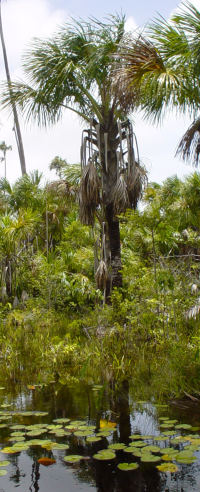
Mauritia is a group of fan palms native to northern South America. One species has a wide distribution that reaches into the Caribbean islands. The other species, M. carana, is found only in the Amazon region.
- Mauritia flexuosa: Found in Trinidad and tropical South America.
Oenocarpus: Palms of Trinidad
Oenocarpus is a group of palms with pinnate leaves found in Central and South America. Oenocarpus bataua is found in Trinidad and along the Caribbean coast of Venezuela.
- Oenocarpus bataua: Found in Trinidad and tropical Panama and South America.
Prestoea: Related to Euterpe Palms
Prestoea is a group of pinnate-leaved palms found in Central and South America and the Caribbean. They are closely related to the Euterpe palms. Two species are found in the Caribbean. P. pubigera is in Trinidad, and P. acuminata is found throughout most of the Caribbean.
- Prestoea acuminata: Found in Cuba, the Dominican Republic, Haiti, Puerto Rico, Leeward Islands, Windward Islands, and Trinidad and Tobago. It also grows in Central and South America.
- Prestoea pubigera: Found in Trinidad and northwest Venezuela.
Pseudophoenix: Palms Across the Caribbean

Pseudophoenix is a group of pinnate-leaved palms found all over the Caribbean. Three species are found only in the Greater Antilles. The fourth, P. sargentii, is found in many places in the northern Caribbean and nearby parts of Central and North America.
- Pseudophoenix ekmanii: Found in the Dominican Republic.
- Pseudophoenix sargentii: Found in the Bahamas, Cuba, Dominican Republic, Haiti, Florida Keys, Puerto Rico, Navassa Island, Turks and Caicos Islands, and the Windward Islands. It also grows in Mexico and Belize.
Reinhardtia: Small Forest Palms
Reinhardtia is a group of palms with simple or palmate leaves. They are found in the wider Caribbean, between Mexico and Colombia. One species is found separately, only in Hispaniola. All species are small, growing 1 to 6 meters (3 to 20 feet) tall, and live in the forest understorey.
- Reinhardtia paiewonskiana: Found only in the southwest Dominican Republic.
Roystonea: Royal Palms of the Caribbean
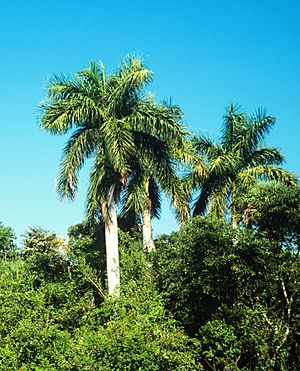
Roystonea is a group of pinnate-leaved palms, often called "royal palms." They grow from south Florida and Mexico down to Venezuela. Seven species are found only in the Greater Antilles and the Virgin Islands. Four of these are found only in Cuba.
- Roystonea borinquena: Found in the Dominican Republic, Haiti, Puerto Rico, and the Virgin Islands.
- Roystonea oleracea: Found in the Leeward Islands, Windward Islands, and Trinidad and Tobago. It also grows in Venezuela and Colombia.
- Roystonea regia: The famous Cuban Royal Palm, found in the Bahamas, Cayman Islands, and Cuba. It also grows in Florida, Mexico, and Central America.
Sabal: Fan Palms of Many Habitats
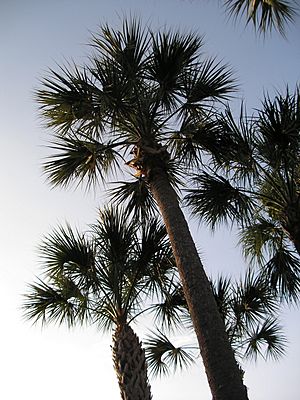
Sabal is a group of fan palms. Six of the sixteen species are native to the Caribbean islands. Three of these are found only in the Greater Antilles and the Virgin Islands. Another species, S. bermudana, is found only in Bermuda.
- Sabal causiarum: Found in Haiti, the Dominican Republic, Puerto Rico, and the Virgin Islands.
- Sabal domingensis: Found in Cuba, Haiti, and the Dominican Republic.
- Sabal palmetto: Found in the Bahamas, Cuba, and Turks and Caicos Islands. It also grows in the southeastern United States.
Syagrus: Lesser Antillean Endemic
Syagrus is a group of palms mostly found in South America. Thirty of the thirty-one species are South American. The other one, S. amara, is found only in the Lesser Antilles.
- Syagrus amara: Found in Montserrat, Guadeloupe, Dominica, Martinique, and Saint Lucia. It grows in coastal areas below 300 meters (984 feet).
Thrinax: Another Fan Palm Group
Thrinax is a group of fan palms. Three of the four species are found only on Caribbean islands. The fourth species grows on Caribbean islands, and also in Florida, Mexico, and Central America. Three species are found only on a single island: two in Jamaica and one in Cuba.
- Thrinax ekmaniana: Found only in Cuba.
- Thrinax excelsa: Found only in Jamaica.
- Thrinax radiata: Found in the Bahamas, Cayman Islands, Cuba, Jamaica, Haiti, the Dominican Republic, and Navassa Island. It also grows in Florida, Mexico, and Central America.
Zombia: The Unique Haitian Palm
Zombia is a palm group with only one species, Zombia antillarum. It is a fan palm found only in Hispaniola. These palms can grow up to 3 meters (10 feet) tall and live in dry, hilly areas. In the Dominican Republic, they are found on special serpentine soils.
- Zombia antillarum: Found in the Dominican Republic and Haiti.
See also
- List of trees of the Caribbean
- List of Arecaceae genera




